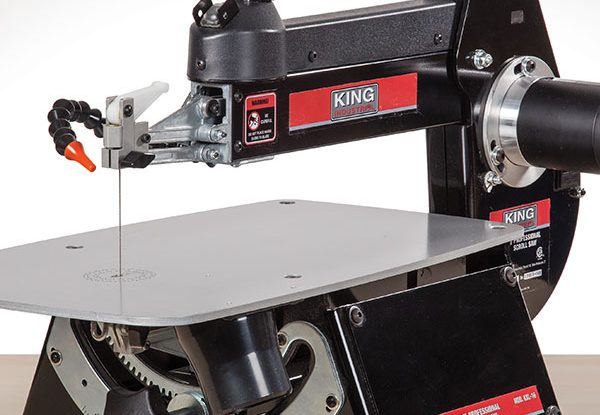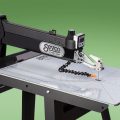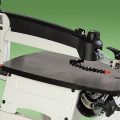King Industrial’s 16″ saw is our new workshop favorite
By the staff of Scroll Saw Woodworking & Crafts
Looking for a new tabletop saw? King Industrial’s new 16″ model is ideal when you want great performance but don’t have a lot of space. This solidly built saw is easy and intuitive to use, and has all the features and capabilities of bigger machines while fitting perfectly into a small shop.
To test the saw, four staff members cut an assortment of projects using high-quality blades. From thin fretwork to thick compound cuts, and soft pine to thick, hard hickory, the saw cut everything, beautifully. Even the newest scroller turned out professional-looking projects. It is our new favorite saw.
Scott Phillips, the host of public television’s “The American Woodshop,” agrees, calling the saw “one of my favorite tools to work on. Over 40 years of scrolling experience makes me give this tool five stars. It’s a smooth-running and easy-to-use saw. My wife, Suzy, uses the saw a lot and she loves it, too.”
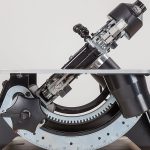 |
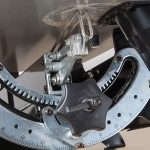 |
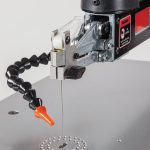 |
|
The saw arm tilts up to 45°, making angled cuts easy and intuitive. |
The saw arm is controlled by a knob connected to a rack and pinion system, so the tilt is easy and accurate |
The blade head and quick tensioning lever make blade changes smooth and simple. |
Saw Features
The saw takes plain-end blades, held in place by thumb screws and adjusted by a quick tensioning lever. The knob at the back of the saw controls the arm height. The idea is that you set the arm height once and leave it alone, using the tensioning lever to tighten and release the blade. It’s a system you’ll recognize from the Excalibur and Seyco saws, and it works smoothly and easily. After just a few minutes of practice, we were able to change and tension blades in seconds.
To make angled cuts the arm tilts, which we find much more intuitive than a tilting table. The tilt is controlled by a rack and pinion system and includes a spring-loaded pin that helps you lock in common angles (such as 45°) and easily restore the blade to vertical. The arm moved smoothly and, when checked with a digital gauge, appeared to set the angle accurately. The arm itself stays up when lifted, which makes feeding the blade from the top or bottom especially easy.
The variable speed control and power switch are located on top of the arm. The dust cover on the power switch is a little stiff out of the box, but should soften with use. The blower works fine. Like most scrollers, we removed the hold-down arm before we started cutting.
The table is 12″ wide by 18 1/2″ deep and should easily accommodate all but the largest fretwork portraits or clocks. That said, we would have liked to see more table space in front of the blade to better balance large projects. And, speaking of the table, it is pierced to facilitate dust collection; more on that in a minute.
This saw comes with small feet to make it easy to level on a benchtop, but we did not use them. It does not have a light. A stand is available separately.
In Action
This saw is a pleasure to use. It cuts smoothly, quickly, and effortlessly. The blade held its tension firmly, was easy to control, and if we drifted off course it was easy to bring the blade back to the line. As long as it’s clamped or bolted down, the saw has minimal vibration and runs smooth as silk. (A stand helps, too, if you have space for one.) This saw is so quiet that, until the board chattered, we didn’t realize a coworker was using it. We could—and did—use this saw all day.
The only thing we didn’t love about this saw is its dust collection system, which consists of a plastic port sized for a standard shop vacuum or dust collection nozzle and a plastic sleeve attached under the holes in the table. The system doesn’t work very well and gets in the way of some saw functions. The holes clog. The vacuum sucks the wood tightly to the table. The plastic sleeve catches bits of wood, makes it harder to change blades, and makes top feeding the blade nearly impossible. The nozzle port keeps the saw arm from tilting all the way to the right, and we had to fumble past it to reach the bottom blade holder. We suggest removing the dust collection system; almost any shop fix (see page 12 for a new one) will do a better job.
We love this saw, but you don’t have to take our word for it—head out to your nearest Woodcraft store and take the King saw for a test drive. Put it through its paces with your favorite blades, types of wood, and scrolling patterns. We think you’ll agree: it’s good to be King!
We recently had the opportunity to talk with Peter Kennedy, Vice President of King Industrial’s industrial division. Peter said the parts for the King scroll saws will fit any of the original black or green Excalibur saws. He can’t make any promises about the new Excalibur saws being made in China (see timeline below). King Industrial is working out a system of service centers. Some parts will be available through King dealers and Woodcraft. If you have a problem, Peter suggests you contact King and they can help (see contact below).
Peter gave us a rough time timeline of the saw’s life.
1982: Somerville Design introduces the Excalibur scroll saws manufactured in Toronto, Ontario. It was originally black, and then purple in color.
2003: General International acquires the assets of Summerville Design including the Excalibur brand. General sends the 21″ scroll saw to Taiwan to be manufactured and adds the 30″ version.
Around 2008: General adds the 16″ version.
2010: EX-21 awarded “Editor’s Choice” by Scroll Saw Woodworking and Crafts magazine.
2012: the EX-21AE 30th anniversary edition is introduced. Only 1,000 units were available. Color changed from green to black and dust collection added to the table, stand and foot switch are included.
2012-2013: General changes all of the scroll saw colors to black and adds the dust collection, stand, and foot switch to all saws. No more General green saws.
Around 2014: General is sold to DMT holdings of Seattle, Wash. The sale included the Excalibur brand, but not the manufacturing rights for the scroll saw. Those manufacturing rights are held by the manufacturer in Taiwan.
2015-2016: JPW (Jet) designs their 22″ saw and has it manufactured by the same Taiwan maker as the original Excalibur saws.
Around 2016: The original Taiwanese manufacturer seeks new North American distribution for the original design of the scroll saws.
2016: King Canada is granted distribution rights to the original 16″, 21″, and 30″ saws for the Canadian market. They are branded Excelsior in Canada and King Industrial in the U.S.
2016: Due to design similarities of the Jet 22″, the manufacturer restricts King’s U.S. distribution to the 16″ and the 30″ versions.
2016: Woodcraft commits to national U.S. distribution of the King Industrial 16″ and 30″ scroll saws.
2017: Seyco introduces their version of the saw manufactured by the same maker as the Excalibur, Excelsior, King Industrial and the JPW saws.
2017: The European saws, such as Azxminster and Pegas, are all made by the same Taiwanese maker. These saws were previously supplied to them by General.
2018: General International (DMT Holdings) begins to market a Chinese-made version of the 21″ saw under the Excalibur name and model number.
In the United States, King Industrial’s 16″ saw is available for $599.99 and a 30″ saw is $899.99, both from Woodcraft at 800-225-1153, www.woodcraft.com. The 16″ stand is $129.99. In Canada, the same saw is called the Excelsior and is available in three sizes: 16″ for $749.99, 21″ for $999.99, and 30″ for $1239.99. Visit www.KingCanada.com to find a local dealer.


